Will Microsoft's rumored 'Surface Phone' be a re-imagined Surface Mini?
During the Spring of 2014 there were big rumors of a small device. Microsoft's Surface Mini, a "digital notepad," was the highly anticipated star of a "small gathering" scheduled for May 20th.
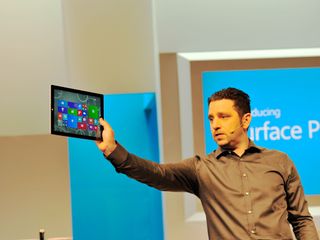
But alas, Microsoft CEO Satya Nadella, and former Executive Vice President of Microsoft Devices, Stephen Elop, determined that the diminutive Surface didn't offer enough to differentiate it from the competition. They concluded that it wouldn't be a hit. Consequently, the Mini was bowed out of the day's event.
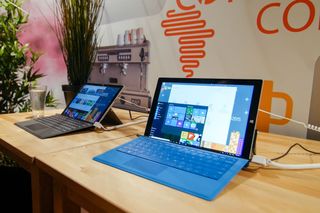
Surface creator and Corporate Vice President of Microsoft Devices Panos Panay is also the "father" of the ill-fated Mini. He shared after that "small gathering" event that Redmond would continue to work on smaller versions of the successful Surface tablet. I believe that we may finally see the manifestation of that passionate commitment next year. Just not in the form of a tablet.
More than one way to skin a cat
As we see with the latest manifestations of the Surface line, the Surface Pro 4, and Microsoft's ultimate laptop, the Surface Book, any product bearing the Surface name is associated with perseverance, pushing limits and creating categories. Consequently, Microsoft's flagship Surface branding has earned the respect of the industry as being about industry leading products and the company's faith in those products.
The Surface Mini had it launched last Summer, would have been introduced into a space littered with 7"- 8" tablets. From a consumer's perspective, the question would have been, what makes Microsoft's small tablet better than the inexpensive and more popular Android devices consumers were already buying in droves? Or in the case of the iPad Mini what makes Microsoft's solution better than Apple's powerfully branded alternative?

It was likely unsatisfactory answers to questions like these that kept the Surface Mini safely out of the public's eye. Not that it was not a great device. It was a Surface after all.
But as a consumer product, it just didn't redefine a category as one would expect something with the "Surface" name to do.
As an 8" tablet, with USB and MicroSD ports, a Qualcomm processor, 1 GB of RAM and the N-Trig pen, it simply checked a box for Redmond. Mini tablet? Check.
Furthermore, though the Surface Mini's evolution began during a period when small tablets were all the rage, that time, by the end of 2014 had passed. There has been a paradigm shift as smartphones have gotten larger. Small tablets have ceded ground to large screen devices or phablets, as users use their 5" plus smartphones for activity that was previously reserved for 7"- 8" tablets.
Get the Windows Central Newsletter
All the latest news, reviews, and guides for Windows and Xbox diehards.
Thus, if as Panay asserts, Microsoft is to bring the Mini (or smaller Surface) to market in any form, it will likely be in a form that better fits the current and foreseeable industry trend. That trend, with the proliferation of phablets, is clearly not one that caters to the simple 8" tablet.
Life Lessons
My dad is an artist. Like most sons who love their dads, as a child, I emulated some of the things I saw him do. Thus, I too became an artist. One of the lessons my dad taught me about my artwork was never to throw any of my work away. I learned that if I didn't get the results I wanted after completing a drawing it still had value. Those areas that didn't quite match up to expectations were opportunities from which to learn. By keeping the work, I had a frame of reference as I started again.
Sleepless Nights

In a recent interview with Wired, Panos Panay shared how during sleepless nights when ideas just won't let him rest, his canceled Surface Mini (kept by his bedside) has been his go-to tool for scribing notes using the new Surface Pen. It is his "digital notepad." The article goes on to share that Panay loves the Mini and that he says,
"It was like a Moleskine"…"It was awesome."
The fact that he still uses the device and considers it awesome, despite it being deemed unfit for the market, reveals Panay's commitment to his "baby." Let's not forget, this is the same man that has passionately and meticulously labored over every detail of his projects. He pushed the Surface line past its initial, highly criticized and money-losing short-comings to the industry-praised and profitable Surface Pro 4 and Surface Book.
Panay is clearly a man that does not give up on an idea. As the head of Microsoft's devices, the faith, and relentless commitment he has in his work clearly leads him to value what is good in a project and to learn from what doesn't work.
His record and his bedside Mini prove that he's not the type of man who will throw a good idea away.
In the making
It has been rumored for some time that Microsoft is making a device that fans and journalists have dubbed the "Surface Phone." Our own Daniel Rubino has referenced his sources numerous times in this regard. So it is no surprise that a prototype that could have been the rumored device was seen on site during the Wired interview.
A few machines away, another machine works on a prototype of a new phone. " – Wired
The fact that Panos Panay is leading the charge for the "Surface Phone" project (as I'll call it) is a promising and exciting prospect for many fans.
The man that made the Surface Mini tablet, who thinks it's awesome and still uses it as a reliable note-taking tool is now responsible for designing smartphones, a category of devices many smartphone users use as mini tablets.
Surely the Mini's cancelation due to lack of differentiation was not the result Panos expected. But those areas of the Mini that didn't quite match up to expectations I'm sure Panos has used as learning opportunities.
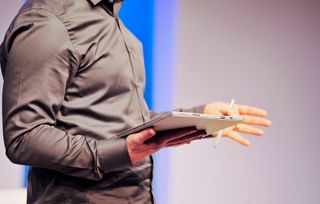
Note, we've learned two things about Panos as we've watched him redefine what a tablet and a laptop are. He is relentlessly persistent and committed to an idea. And he uses constructive criticism to reshape a product to fit the user's needs while remaining true to the products original vision. He doesn't "cancel" an idea.
As mentioned above the mini tablet space is a shrinking market. It is progressively ceding ground to the growing phablet space. Redmond is clearly aware that creating a device that is simply a mini tablet would be a poor investment. Microsoft, however, is a company that is leading the way in convergence devices and software as seen in the Surface line and Windows 10 platform features like Continuum for PC and phone.
This company is in a better position than any other to optimize on the natural flow of the industry toward that converged mini tablet and smartphone space.
Keeping the baby
There's an old saying that says, "don't throw the baby out with the bathwater." It's simply an advisement that when discarding something of little to no value, don't lose what's important.
"This device is the pen and paper killer." – Brad Sams
This was the impression of fellow writer Brad Sams, who had hands-on time with the Surface Mini. Based upon how Panos Panay, the Mini's creator, uses his Mini, it seems that Brad's analysis provides an accurate allusion to what the Mini's potential market positioning would have been.
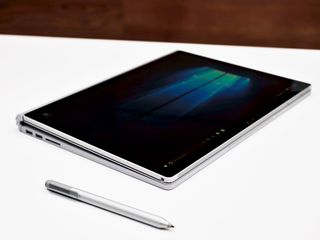
Its small size complemented by the Surface Pen made it ideal as a digital notepad.
Now as an 8" tablet running the largely criticized Windows 8 in 2014, surrounded by the iPad Mini and Android tablets galore, this "digital notepad" though commendable, would not have been very visible in that highly competitive landscape.
As we approach 2016 however, and the industry naturally flows toward a "single device for multiple scenarios" paradigm and small tablets yield ground to phablets, Microsoft's Windows 10 and Universal Windows Platform with Continuum provide the ideal environment for a re-imagined and differentiated "digital notepad."
In 2014, Microsoft's "digital notepad" would have been the Surface Mini. In 2016, Panos Panay and team will likely present the re-imagined "digital notepad" in the form of the "Surface Phone."
In with the new
As a 5" – 7" phablet, the anticipated Surface Phone will lend itself to comfortable internet surfing, multimedia consumption, and productivity tasks. However, with added telephony capabilities, the Surface Phone, unlike the Mini will always be connected without the need for a separate cellular plan or dependency on Wi-Fi.
Additionally, in potentially retaining the defunct Mini's focus as a "digital notepad" Microsoft can continue the theme of intricate integration of the Surface Pen with Surface devices when applied to the "Surface Phone". It will be interesting to see how Windows 10 evolves and how expected features like interactive Live Tiles are optimized for pen-centric interaction.
Also, as a new category of Surface, Microsoft will be able to position the Surface Phone to fill a gap in their existing Surface line.

Consider. As Microsoft's tablet that can replace your laptop, the Surface is positioned as a productivity tablet. Thus, Microsoft has the large tablet space and the various use case scenarios served by that tablet size covered.
The Surface Book, Redmond's ultimate laptop is first and foremost a powerful laptop. The ability to detach the display and use it as a digital clipboard (and not a tablet per Panay) is designed for specific purposes that doctors, architects, and others may find useful.
The anticipated Surface Phone will fill the currently unaddressed and lowest end of the Surface continuum that was likely the originally intended position for the Surface Mini. The Surface Phone will be the always connected "digital notepad" for everyday scenarios. The student, the salesman, the executive, the administrative assistant, the nurse, the professional and even the regular Joe would find this digital notepad useful.
The differentiator that makes this "Surface" more viable than the Mini, is this always connected device's ability through Windows 10 and Continuum to go from a pocketable pen-centric "digital notepad" to a PC experience in seconds. Additionally, with an anticipated "Intel inside," Continuum from this device is expected to literally put a PC in user's pockets.
With the additional potential to run Win32 apps ported over by way of the app conversion Bridge, Centennial, this device can fill the range from a light-weight "digital notepad" to a powerful PC.
Reborn
Since users in the current market, are increasingly looking to do more with a single device, the anticipated Surface Phone potentially fills a market position the original Surface Mini and all current small tablets do not address.
The "Surface Phone", if it materializes, will be a phone that, like other phablets replaces a user's tablet. However, with Windows 10 and Continuum, it will also run Universal Windows apps and become a user's PC. These features are in addition to the pen-centric theme of the Surface line and the legacy focus of the Surface Mini as a "digital notepad."
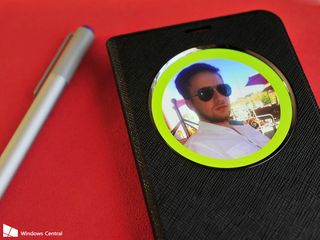
It's not a stretch to imagine that when Microsoft's Corporate Vice President for Devices Panos Panay wakes late at night and grabs his Surface Pen and Surface Mini, that he scribbles ideas into the device regarding how to ensure the strengths of the Mini that he so loves to live on.
Yes, I believe that if Panay has his way, his "Surface Mini" will endure. Indeed, I contend that the "digital notepad" that was canceled in 2014 will likely be reborn as the highly anticipated "Surface Phone" in 2016.
Are you looking forward to a Surface Phone? Sound off in comments!
Jason L Ward is a columnist at Windows Central. He provides unique big picture analysis of the complex world of Microsoft. Jason takes the small clues and gives you an insightful big picture perspective through storytelling that you won't find *anywhere* else. Seriously, this dude thinks outside the box. Follow him on Twitter at @JLTechWord. He's doing the "write" thing!

